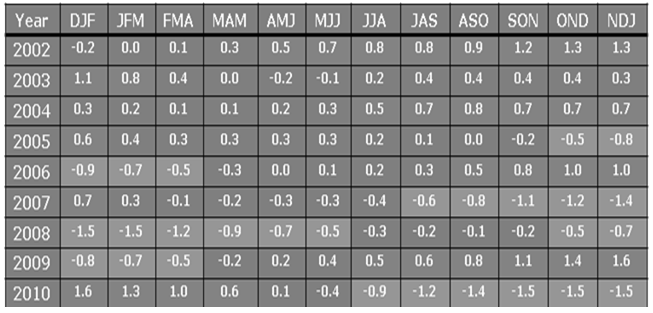-
Paper Information
- Next Paper
- Previous Paper
- Paper Submission
-
Journal Information
- About This Journal
- Editorial Board
- Current Issue
- Archive
- Author Guidelines
- Contact Us
American Journal of Environmental Engineering
p-ISSN: 2166-4633 e-ISSN: 2166-465X
2015; 5(1A): 34-38
doi:10.5923/s.ajee.201501.05
Regions of Occurrence of Natural Disasters by Sudden Flood and Drought on Rio Grande do Sul from Period 2003 to 2009
Anderson Spohr Nedel 1, Campos C. R. J. 1, Saito S. 2, Tania Maria Sausen 2
1Faculdade de Meteorologia, Universidade Federal de Pelotas, Campus Capão do Leão, Pelotas, RS, Brasil
2Centro Regional Sul de Pesquisas Espaciais, Santa Maria, RS, Brasil
Correspondence to: Anderson Spohr Nedel , Faculdade de Meteorologia, Universidade Federal de Pelotas, Campus Capão do Leão, Pelotas, RS, Brasil.
| Email: |  |
Copyright © 2015 Scientific & Academic Publishing. All Rights Reserved.
This paper aims to carry out a mapping of natural disasters, droughts and gradual floods, occurring in Rio Grande do Sul (RS) state from period 2003 a 2009. Records of the events were obtained by State Civil Defense Authority to analyze the preferential period for these occurrences and the most affected areas. The results show that regarding the gradual floods, the areas of RS most affected were Depressão central (35%), the lowlands of Planalto Médio (18%), Alto Uruguai (14%), Encosta inferior do Nordeste (10%) and Missões (9%) regions. For the drought was observed that the Alto Uruguai region was the most affected (38% of the events), accompanied by Planalto Médio (19%), Missões (11%) and Depressão Central (11%) regions. The period between the finish of spring season and begin of the summer season were the preferential for the occurrences. Also was found that droughts and gradual floods did not occur only in years with presence of El Niño and La Niña climatic events. It’s also occurred in periods without the influence of these phenomena (neutral years).
Keywords: Natural Disasters, Droughts, Flood, mapping, Adverse Events
Cite this paper: Anderson Spohr Nedel , Campos C. R. J. , Saito S. , Tania Maria Sausen , Regions of Occurrence of Natural Disasters by Sudden Flood and Drought on Rio Grande do Sul from Period 2003 to 2009, American Journal of Environmental Engineering, Vol. 5 No. 1A, 2015, pp. 34-38. doi: 10.5923/s.ajee.201501.05.
Article Outline
1. Introduction
- According to the Civil Defense Glossary, Risk Studies and Disaster Medicine (2001), disasters are the result of processes (events) natural or anthropogenic (man-made) acting on a certain place, causing human damage, environmental / materials, and of economic and social losses. Natural disasters (ND) could be said to be the sum of natural events (NE) and the vulnerability of a place (V); ND = EN + V. Abrupt and gradual droughts and floods are among the natural disasters that occur most commonly in Brazil, especially in Rio Grande do Sul.Data for Brazil from the Center for Research on the Epidemiology of Disasters at the Catholic University of Louvein, Belgium (EM-DAT), show that between 2000 and 2008 natural disasters such as floods, droughts, landslides, cold waves and extreme heat were responsible for the deaths of hundreds of people, achieving economic losses that exceeded four billion US dollars. These data show that natural disasters in Brazil tend to be associated with climate instability and are therefore have an atmospheric origin, (Santos, 2007).There is evidence that over the last few years the rainfall and extreme weather events have increased in intensity and frequency on a global basis. According to some researchers, this may be related consequence of human actions Such as rapid urbanization of cities, soil sealing, deforestation and silting of rivers, poor planning and use of watersheds, increased air pollution, etc. According to the Intergovernmental Panel on Climate Change (IPCC, 2007a, b, Marengo et al, 2009), "... in many parts of South America, the frequency of precipitation events has increased, consistent with heating, and various regions, changes in temperature extremes have been observed over the last 50 years." Severe droughts events have been a recurrent event for much of the Brazilian population, especially in the densely populated South region which is highly dependent on the availability of water to feed its productive industries. Droughts can cause serious impacts on society and severely affect various economic spheres of the region such as agriculture and energy generation. The objective of the current study is to create a zoning for natural disasters, droughts and sudden floods that occurred in the state of Rio Grande do Sul (RS) between 2003 and 2009, based on notifications (instances) of the state civil defense.
2. Methodology
- Rio Grande do Sul (RS) is located in the extreme south of Brazil and adjoins Santa Catarina (SC) state to the north, Uruguay to the south, Argentina to the west, and the Atlantic Ocean to the east (Figure 1). Among the major weather systems that affect and determine the occurrence of natural disasters that State are cold fronts and mesoscale convective systems (MCS). At a larger scale (hundreds to thousands of kilometers), RS is influenced by ocean-atmosphere interactions such as El Niño and La Niña - which are characterized, respectively by heating and cooling of the waters of the equatorial pacific Ocean, and which directly influence the frequency and severity of floods and severe drought in southern Brazil.
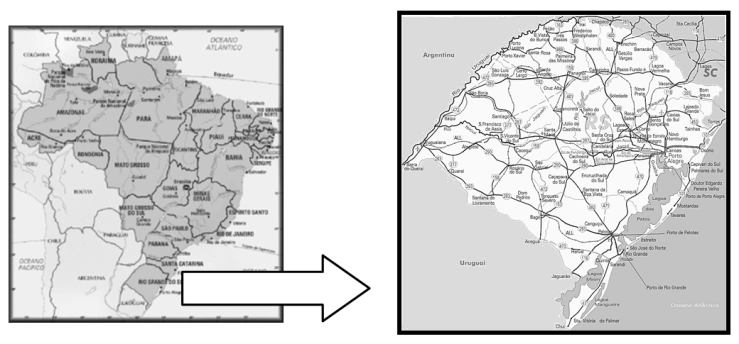 | Figure 1. Map with Rio Grande do Sul (RS) state |
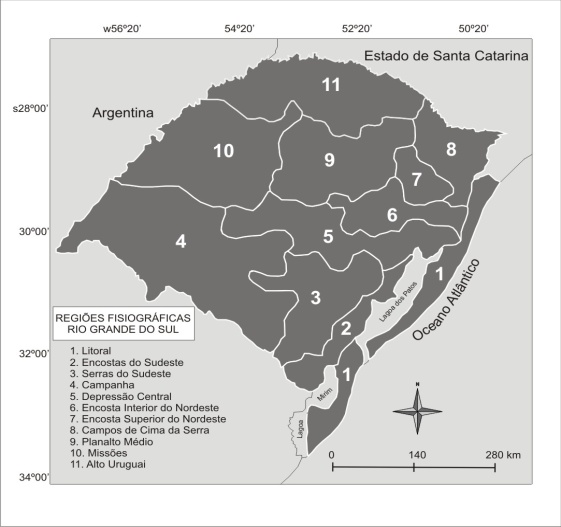 | Figure 2. Physiographic regions of Rio Grande do Sul. Source: SEMA/RS |
3. Results
- The frequencies and the preferred regions of occurrence by sudden flood events (a) and dry (b) in Rio Grande do Sul, between 2003 and 2009 are showed in Figure 3. Among 1972 natural disaster occurred, the drought episodes caused the biggest problems, i.e., affected most municipalities (1292) to report emergency situation, such is the gravity of the situation.
3.1. Sudden Flood Events
- Figure 3 shows the recorders of events that affected RS from years 2003 to 2009. It may be noted that these events occurred predominantly during spring season. The month of December showed the highest number of sudden flood events (54 events), after the months of September (19 events) and October (18 events), respectively (Figure 3b). The beginning period and finish of the seasons was based on dates: Autumn - March, 20th to June, 19th ; Winter - June, 20th to September 20th; Spring - September 22th to December 20th; Summer - December, 21th to March, 19th.
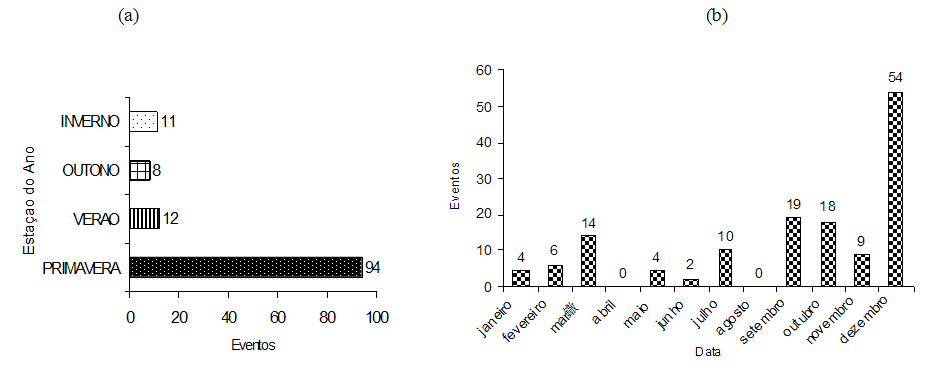 | Figure 3 |
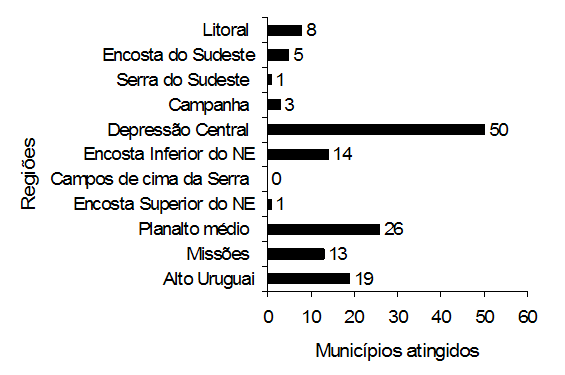 | Figure 4. Spatial distributions of sudden flood in Rio Grande do Sul state. Period 2003 a 2009 |
 | Figure 5. Municipalities in Rio Grande do Sul state with drought record, in the period 2003 a 2009 |
3.2. Drought Events
- Figures 6, 7 and 8 show the episodes of drought that occurred in RS during the nine years of study. It is observed the distribution of these events throughout the seasons of the year, finding that the preferred station for its occurrence is summer (811 events) followed by autumn (442 events) - presenting the first (summer) almost twice the second (fall) - figure 6a. It may be noted as well (Figure 6b) that March was month in which the municipalities were have suffered most by drought (426), followed by months of January and February, with 295 and 210 recorded, respectively. Similary to Sudden floods, the beginning period and finish of the seasons was: Autumn - March, 20th to June, 19th ; Winter - June, 20th to September 20th; Spring - September 22th to December 20th; Summer - December, 21th to March, 19th.
 | Figure 6. Frequency of drought occurrences in RS, according to season of the year (a) and months of the year (b) from 2003 to 2009 |
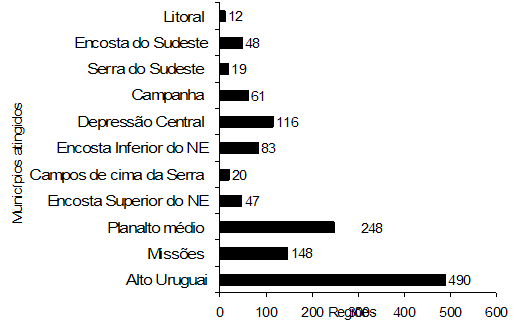 | Figure 7. Distribution of drought regions in Rio Grande do Sul in the period 2003 to 2009 |
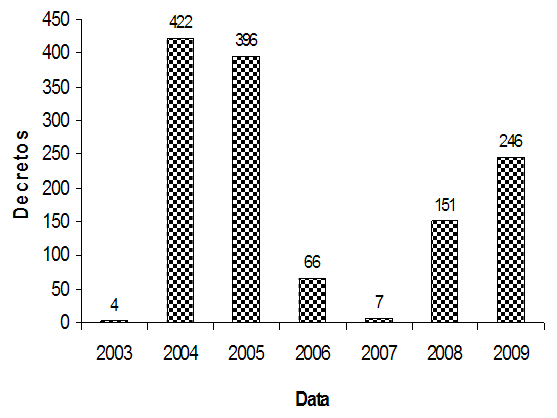 | Figure 8. Municipalities in Rio Grande do Sul with drought record, in the period 2003 to 2009 |
4. Conclusions
- This study aimed to carry out zoning of natural disaster by droughts and sudden floods, in Rio Grande do Sul (RS) state, between years 2003 and 2009. Were analyzed the number of occurrences, the preferred regions and the more favorable period for them occurrences. Some conclusions can be showed:(i) Regarding the sudden floods: The spatial distribution of the floods showed that about half of the episodes were established in RS municipalities of Depressão Central and Encosta Inferior do Nordeste e Sudeste regions. Other regions frequently affected by floods were the areas of Planalto Médio (18%) and the Alto Uruguay (14%).Anual behavior of sudden floods between 2003-2009 showed a higher frequency of occurrence in the years 2003, 2007 and 2009: 49 municipalities affected in 2003, 31 in 2007 and 40 records in year 2009. Its emphasized year 2009 which presented (since the end year 2008) one of the worst sudden floods (if not most) already registered by gaucho state (RS), with severe damage to summer agricultures (corn and soybeans). This time SST on Equatorial Pacific Ocean there was close to normal (neutral year). Since second half, temperature anomalies positive signs beginning to appear, setting a new El Niño event (2009-2010), causing severe accumulated precipitations over RS in late year 2009 and early 2010.(ii) Regarding the Drought:The events recorded by the municipalities of Rio Grande do Sul was 1292, and the most affected regions were Alto Uruguay (490 events, 38%) Planalto Médio (248 events, 19%), Missões (148 events, 11%: ), the Depressão Central (116 events; 9%), Encosta Inferior do Nordeste (83 events; 6%) and Campanha regions (61 events; 5%). It is clear that northern half of state was region with the largest number of emergency situation decrees by drought (70%) and that suffered most from this type of adverse weather conditions. The hypothesis to be investigated (object of further study) is that factors such as topography of the region, morphological characteristics of soil, irregular distribution of rainfall during dry season (summer/fall), economic factors, etc.., may contribute for high frequency these drought events in the region.The most intense episodes occurred over years 2004, 2005 and 2009, and many municipalities affected: 422, 396 and 246, respectively. In the analysis of period (2003-2009) it was observed that most drought decrees occurred in the presence of years El Nino (weak) phenomenon. Only in 2008 the events were influenced by presence of La Niña phenomenon (2007/2008: strong).The period with greatest occurrence of drought was the summer, followed by autumn, with records of 811 and 442 (municipalities affected), respectively. According to the emergency decrees, March was record the largest number of episodes (426), followed by January (295) and February (210). It is believed that this fact is directly related to the summer agriculture (soy and corn) of these municipalities, that breaks in productivity (yield) of these crops would cause drastic losses in the economy of the municipalities - which are based (soy and corn) in the agricultural sector - leading them to enact Emergency Situation (SE) in order to help (financial) of state and federal agencies.Also became evident that not only in years with the presence of El Niño and La Niña occurred in Rio Grande do Sul extreme weather situations, such as drought and sudden flood events. It was found that the years of thermal neutrality (with the absence of phenomena) are also important and deserve to be analyzed with better attention, especially with regard to the impact (event type) caused by them.
References
| [1] | CLIMANÁLISE, 2007: Boletim de Monitoramento e Análise Climática. INPE/CPTEC, 2007. v.1 a 12. São José dos Campos - SP. Brasil. |
| [2] | SECRETARIA ESTADUAL DE DEFESA CIVIL RS. Centro de Operações da Defesa Civil. Disponível em www.defesacivil.rs.gov.br. Acesso em 16/01/2010. |
| [3] | EM-DAT. Emergency Events Database, Base de dados da Universidade Católica de Louvein, Bélgica. Disponível em http://www.emdat.be. Acesso em 28/08/2009. |
| [4] | FORTES, A. B., 1959: Geografia Física do Rio Grande do Sul. Ed. Globo. Porto Alegre/RS, Brasil. |
| [5] | GLOSSÁRIO DE DEFESA CIVIL, 2001: Estudos de riscos e medicina de desastres. Ministério de Integração Nacional. Secretaria Nacional de Defesa Civil. Volume único, 283 pp. Brasília/DF. Extraído de http://www.defesacivil.gov.br. Acesso em 27/02/2010. |
| [6] | INMET, Instituto Nacional de Meteorologia. Disponível em http://www.inmet.gov.br . Acesso em 22/02/2010. |
| [7] | Intergovernamental Panel on Climate Change IPCC., The Physical Science Basis Summary for Policymakers Contribution of Working Group I to the Fourth Assessment Report of the Intergovernmental Panel on Climate Change, (2007a), pp. 18. |
| [8] | MARENGO, J. A.; JONES R.; ALVES, L; VALVERDE, M., 2009: Future change of temperature and precipitation extremes in South America as derived from the PRECIS regional climate modeling system. International Journal of Climatology (In press). |
| [9] | SANTOS, R. F., 2007: Vulnerabilidade Ambiental. Desastres naturais ou fenômenos induzidos? Instituto do Meio Ambiente e dos Recursos Naturais Renováveis. MMA, Brasília/DF, Brasil. 192pp. |
 Abstract
Abstract Reference
Reference Full-Text PDF
Full-Text PDF Full-text HTML
Full-text HTML